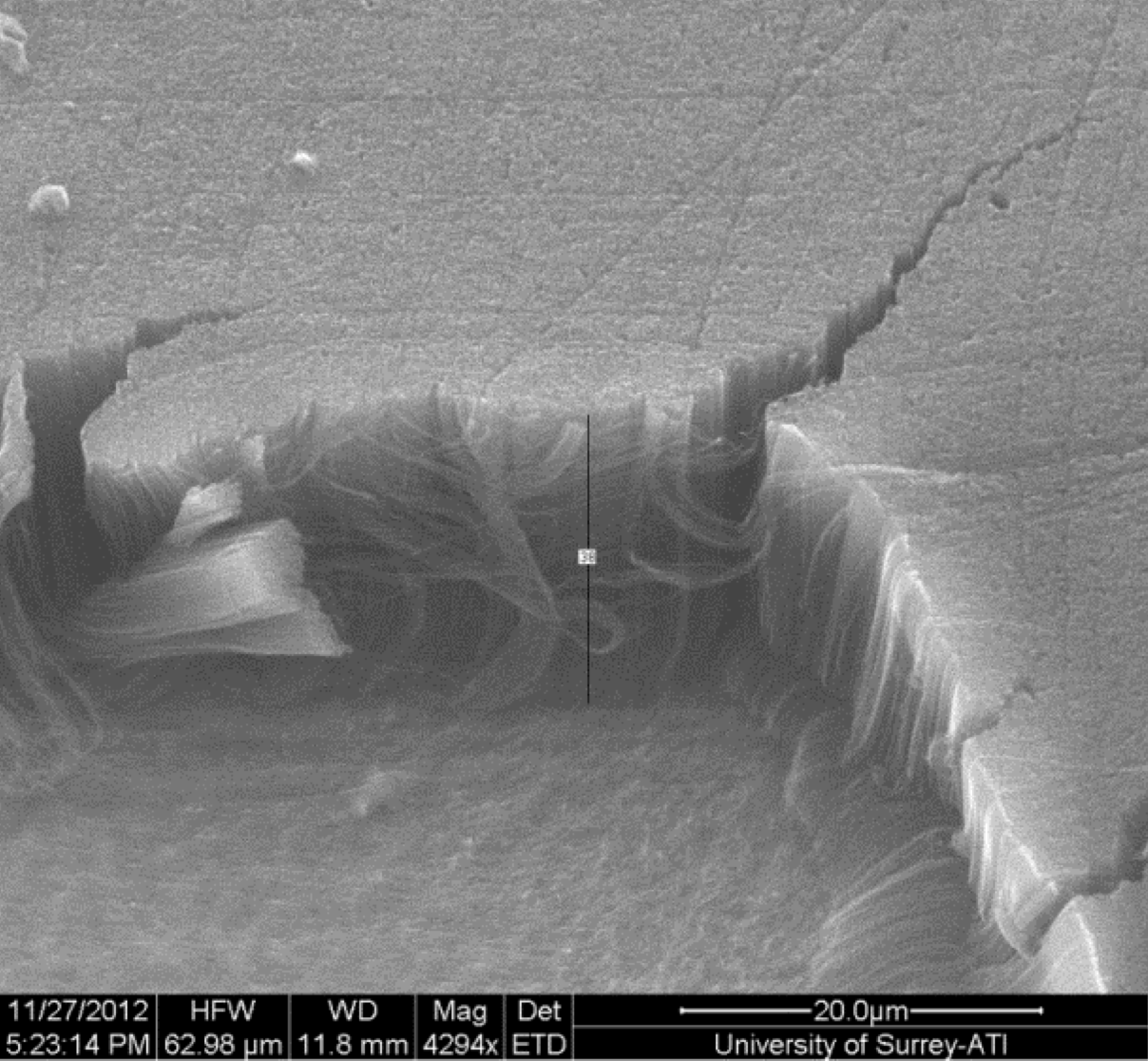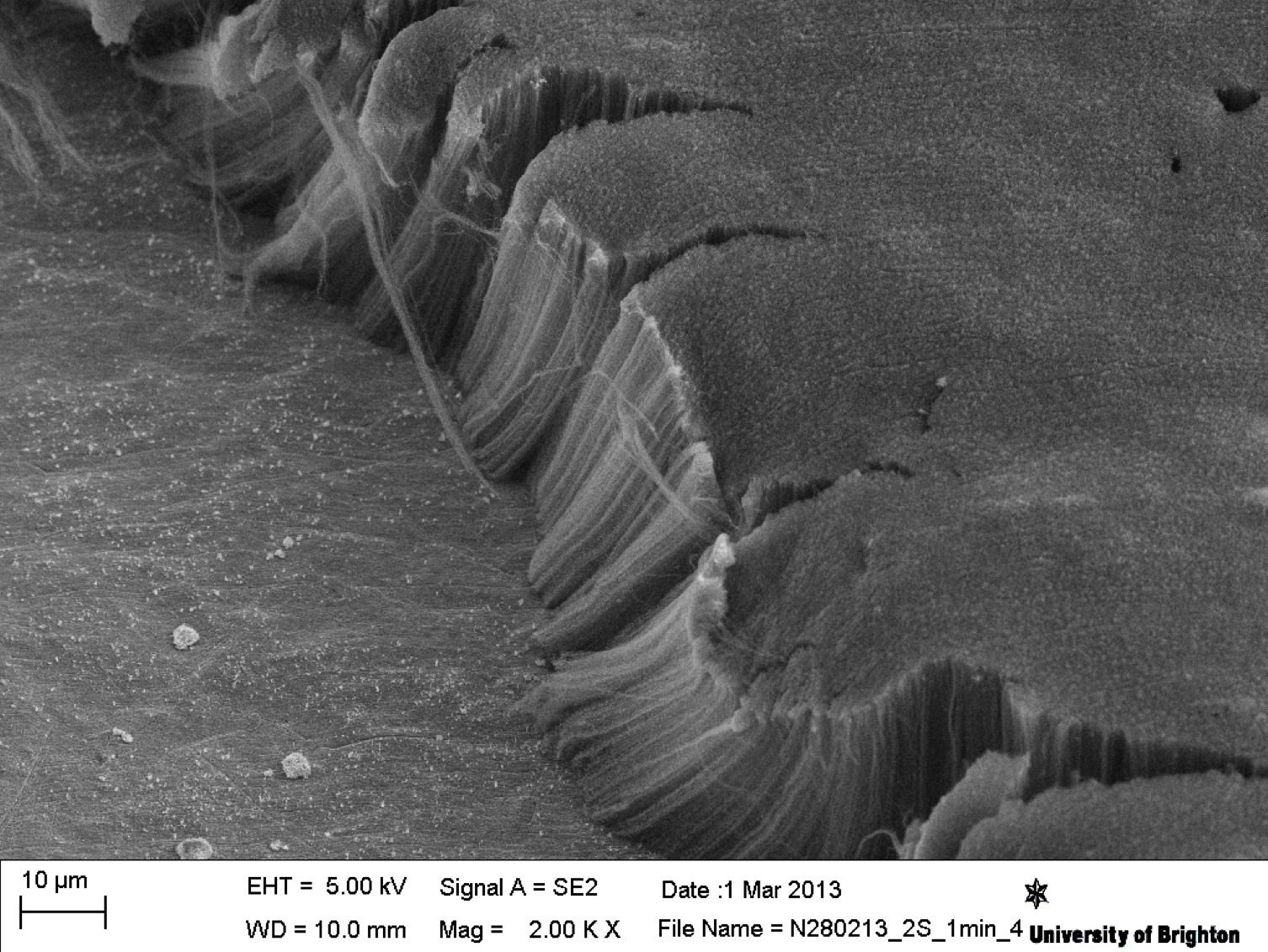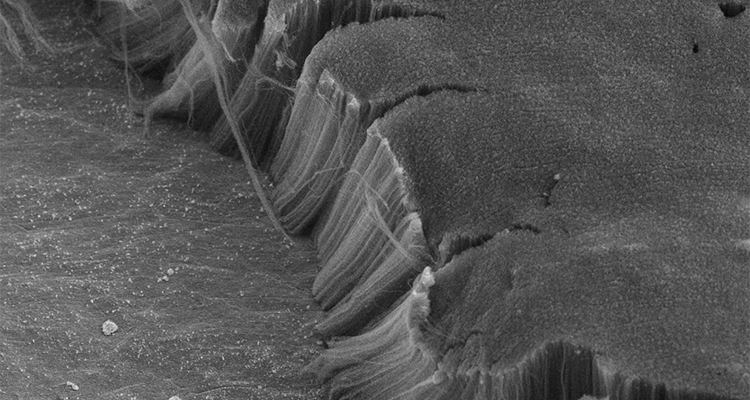Vantablack – the new black?
Over the past few days, the interweb’s been awash with virtual “oohs” and “ahs” over Surrey Nanosystems’ carbon nanotube-based Vantablack coating. The material – which absorbs over 99.9% of light falling onto it and is claimed to be the world’s darkest material – is made up of a densely packed “forest” of vertically aligned carbon nanotubes (see the image below). In fact the name “vanta” stands for Vertically Aligned NanoTube Array.
Vantablack makes for a great story – so much so that while the coating is designed for space-based optical applications, some journalists couldn’t resist speculating about the potential for using the product with clothing – and especially for crating the ultimate “little black dress“.

Scanning Electron Microscope image of a VANTA coating grown on an aluminum substrate after to it was subjected to the space qualification tests. Source: Theocharus et al. (2014) Optics Express. Used with permission.
Safety alarm bells
Perhaps not surprisingly, this began to ring alarm bells with me as someone who’s worked for a number of years on the potential health risks of carbon nanotubes. There’s a growing body of research that suggests carbon nanotubes can be potentially harmful if inhaled – especially if they are long, thin and straight. And because of this, applications that look like they could lead to people being exposed to carbon nanotubes concern me.
The critical word here though is “exposed”.
Negligible exposure, negligible risk
Following up, I checked in with Surrey Nanosystems Chief Technology Officer Ben Jensen on what is currently known about the potential for people to be exposed to Vantablack nanotubes.
Ben clarified that Vantablack is designed for use in tightly controlled and highly predictable environments where people cannot come into contact with the material – environments such as satellite-based optical systems. This is most definitely not aimed at consumer products! He also pointed me to a recently published paper in the journal Optics Express that describes the material in detail, and provides data on tests designed to evaluate how well the nanotubes stick to the coated surface. After all, if it’s to be used in a mega-expensive orbiting optical detector, the last thing you need is clumps of carbon nanotubes fouling up your sensor.
This paper specifically addresses the material’s performance specifications for space-based applications, and addresses, amongst other things, particle fall-out when surfaces are vibrated and shocked.
There were no tests carried out on what happens when someone runs their greasy fingers over Vantablack, or rubs away at it with a polishing cloth because, not surprisingly, that sort of thing doesn’t tend to happen in orbit. The results showed that the material is robust enough to prevent significant nanotube detachment and release when used in extremely sensitive space-based optical applications.
So the only potential exposure for people to Vantablack nanotubes would be during manufacture and transport.
Abrasive release of carbon nanotubes?
I would assume that, during manufacture and transportation, all care would be taken to protect these precision coated surfaces, and so the chances of material release through inadvertent abrasion or handling would be very small. But what if the material was manhandled – do we know what the likelihood of potentially dangerous carbon nanotubes being released is?
I emailed a few colleagues who have worked extensively in this field if they were aware of any research on nanotube release from vertically aligned nanotube arrays. So far the answer is no – there’s research on the release of discrete carbon nanotubes from composite materials (extremely low), but virtually nothing is known about these nanotube arrays.

Scanning Electron Microscope image of a VANTA coating grown on an aluminum substrate after to it was subjected to the space qualification tests. Source: Theocharus et al. (2014) Optics Express. Used with permission.
Based on the physical form of the Vantablack coating, it’s reasonable to assume that clumps of nanotubes – not necessarily individual nanotubes – could be abraded from the surface. From electron micrographs of the material, these would be several micrometers long – long enough to cause your lungs problems if inhaled in any quantity. But it’s also likely that the individual carbon nanotubes would be very hard to separate out from these clumps – a factor that would reduce exposure individual nanotubes.
In the absence of any other data at this point, it’s reasonable to assume that Vantablack is pretty safe – not because the material it’s made of isn’t toxic, but because, when used as intended, the chances of this material getting into someone’s body are vanishingly small.
That said, I’d be hesitant about using the coating in areas where it can be readily abraded and people potentially exposed to any material released.
And this, not surprisingly, includes using it to create the ultimate little black dress!
Image: Scanning Electron Micrograph of a VANTA coating grown on an aluminium substrate after to it was subjected to the space qualification tests. Source: Theocharus et al. (2014) Optics Express. Used with permission
Useful additional reading:
Theocharious et al. (2014) The partial space qualification of a vertically aligned carbon nanotube coating on aluminium substrates for EO applications. Optics Express. DOI: 10.1364/OE.22.007290
Kingston et al. (2014) Release characteristics of selected carbon nanotube polymer composites. Carbon. DOI: 10.1016/j.carbon.2013.11.042
Poland et al. (2008) Carbon nanotubes introduced into the abdominal cavity of mice show asbestos-like pathogenicity in a pilot study. Nature nanotechnology. DOI: 10.1038/nnano.2008.111
NIOSH (2013) Current Intelligence Bulletin 65: Occupational Exposure to Carbon Nanotubes and Nanofibers. DHHS (NIOSH) Publication Number 2013-145
2020 Science (2013): Carbon nanotubes as a potent cancer promoter – new data from NIOSH

